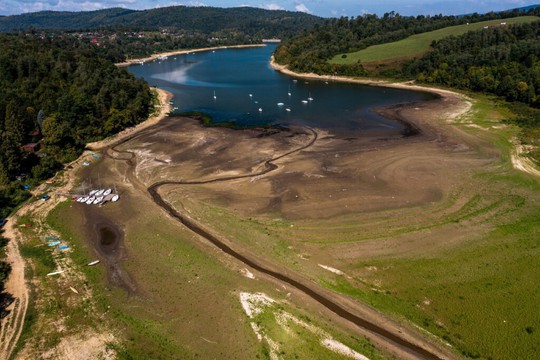Photo: EFE via EPA
The Continent is bracing for yet another drought after a winter with little rain and snow. It’s barely spring, and Europe is running dry, writes POLITICO.
A conflict over water triggered clashes in France, where several villages can no longer provide their residents with tap water.
Italy’s largest river is already running as low as last June.
More than a quarter of the Continent is in drought as of April, and many countries are bracing for a repeat — or worse — of last year’s bone-dry summer.
A study using satellite data confirmed earlier this year that Europe has been suffering from severe drought since 2018. Rising temperatures are making it difficult to recover from this deficit, leaving the Continent stuck in a dangerous cycle where water becomes ever more precarious.
“A few years ago I would have said we have enough water in Europe,” said Torsten Mayer-Gürr, a lead author of the satellite study. “Now it looks like we could face problems.”
Drought, said Spanish Prime Minister Pedro Sánchez, “is going to be one of the central political and territorial debates of our country over the coming years.”
France, where no rain fell for more than 30 consecutive days in January and February, experienced its driest winter in 60 years.
Italy’s CIMA research foundation found a 64 percent reduction in snowfall by mid-April. The River Po runs as low as it did last summer; Lake Garda is already at less than half its average level.
Catalonia is in a state of emergency after 32 months of drought.
A report from Spanish farmers’ association COAG stated that some cereals need to be “written off” across four entire regions this year; one meteorologist told El País to “say goodbye to almost the entire olive harvest.”
The Sau reservoir north of Barcelona has dropped so low that authorities decided to remove fish to avoid them dying off and contaminating the region’s water supply. Across Catalonia, reservoirs stand at only 27 percent — in April.
Predicting precipitation over such long periods is tricky, especially with climate change altering rainfall patterns. One of the few long-term projections, the German weather service’s 2020s forecast, predicts the country will see less rather than more rainfall for much of the decade.
But even if precipitation levels stay the same, climate change will reduce water availability across swaths of Europe.
Finally, Europe’s glaciers and snow cover are rapidly shrinking thanks to rising temperatures — depriving major rivers like the Rhine, the Danube, the Rhône or the Po of vital supply.
This year, the contribution of meltwater to Europe’s water reservoirs “will be really much less than usual,” said Andrea Toreti, a senior researcher at the European Commission’s Joint Research Center.
“Poland and other regions like Bulgaria, Romania, Greece are showing warning conditions for drought,” he said. The European Drought Observatory also indicates water stress across Nordic countries.
Capitals — scarred by last summer’s devastating effects on sectors including agriculture, energy and industry — are scrambling to draft responses to current and expected shortages.
Earlier this month, Italy issued a drought decree reducing red tape for water infrastructure, including desalination plants. Spain in January published a new set of water management plans.
French President Emmanuel Macron’s new national water management strategy is aimed at reducing overall water consumption by 10 percent by the end of the decade. Under the plan, each sector will be asked to draw up proposals to reduce their water use.
Germany’s strategy, adopted in March, includes steps to make water use “sustainable” in 10 areas by 2050, as well as a slate of 78 measures to be implemented by 2030.
Meanwhile, managing water — and deciding who gets access to it — is turning into a political issue across the Continent.
Last summer, water use restrictions were imposed in the U.K., France, Spain and Italy, raising questions about the prioritization of water use for touristic infrastructure, big industrial installations and agriculture.
Some municipalities already face new restrictions — in others, they were never lifted. Catalonia recently imposed limits, including a mandatory 40 percent reduction in water consumption for agriculture.
In southern Germany, legal disputes over water have doubled over the past two decades. And in France, tensions between environmentalists and farmers over the construction of water reservoirs last month sparked violent clashes.
read more in our Telegram-channel https://t.me/The_International_Affairs

 10:21 06.05.2023 •
10:21 06.05.2023 •























